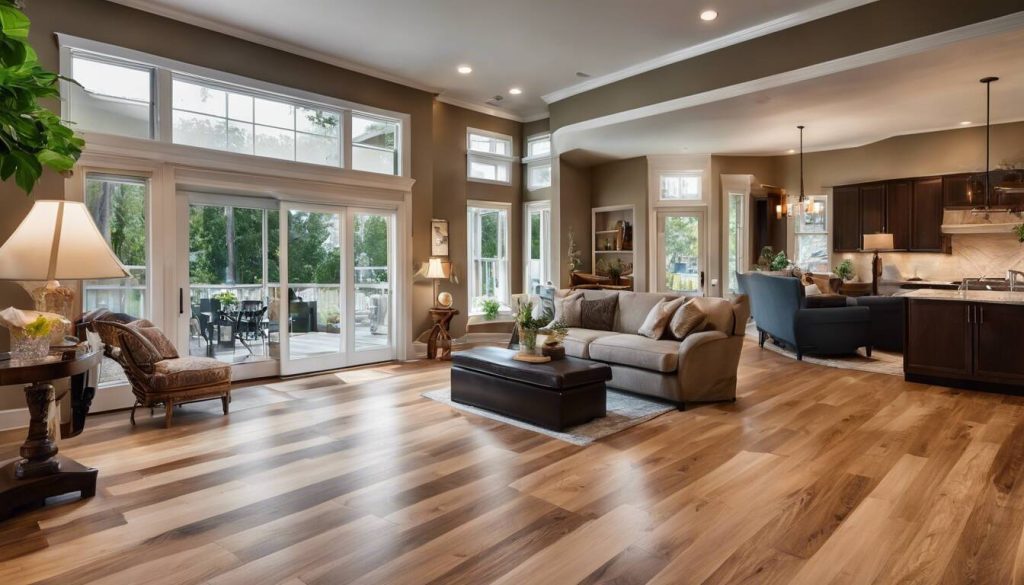Navigating Insurance for Senior Home Adaptations: A Comprehensive Guide
You're not alone in wanting to stay at home while growing older and wondering how insurance fits into the plan. Many types of insurance, like Medicare, often cover crucial home adjustments that make a house safer for senior citizens. Picture a home with ramps replacing stairs or grab bars installed in bathrooms - these are typical changes getting covered under certain health insurances. It's a path many have walked before and navigating it comes down to knowing what's possible under your plan. Let's start untying this knot together.
Seniors can navigate insurance for home adaptations by discussing potential modifications with their insurance agent to determine if additional coverage is needed. They should consider the type of home they have and may want to explore policies such as HO-3, HO-5, or HO-8, based on the value and unique characteristics of their homes. It's also important to explore possible discounts and coverage adjustments by comparing quotes from multiple companies.
Types of Insurance for Home Adaptations
 When making home adaptations for senior citizens, it's essential to consider how these modifications will be covered by insurance. Here are the various types of insurance that can offer coverage for home adaptations:
When making home adaptations for senior citizens, it's essential to consider how these modifications will be covered by insurance. Here are the various types of insurance that can offer coverage for home adaptations:
Medicare
Medicare is a federal health insurance program primarily for individuals aged 65 and older. It may cover medically necessary home modifications such as ramps and grab bars if prescribed by a healthcare provider and deemed essential for the patient's health and safety.
This means that if your physician determines that certain modifications are crucial for your well-being and safety, Medicare may assist in covering the costs. This is especially important when considering significant changes to your living environment, ensuring that you can navigate your home safely and comfortably as you age in place.
Medicaid
Medicaid offers Home and Community-Based Services (HCBS) waivers that may cover home modifications for seniors who qualify. The coverage varies by state and is usually based on individual needs and budget. It's important to explore the specific guidelines and provisions set forth by your state to understand eligibility criteria and coverage details.
The key advantage of Medicaid waivers is their focus on providing necessary services and supports to individuals while allowing them to live at home or in their communities. By providing coverage for home modifications, Medicaid helps seniors maintain their independence and quality of life within familiar surroundings.
Private Health Insurance
Some private health insurance plans may offer coverage for home adaptations, but the extent of coverage depends on the policy and the specific insurance provider. It's important to carefully review your insurance policy to understand the scope of coverage for home modifications and whether any additional riders or endorsements are required to enhance coverage options.
For instance, some private insurance plans may provide coverage for adaptive equipment, such as stair lifts or bathroom modifications, which can significantly contribute to creating a safe and accessible living environment for seniors. However, the specifics of coverage can vary widely among different insurance providers.
Understanding the diverse range of insurance options available for home adaptations is vital in determining the most suitable avenues for obtaining financial support to facilitate necessary modifications for aging in place. Each type of insurance presents distinct eligibility criteria, coverage details, and benefits tailored to address the unique needs of seniors seeking to enhance their living spaces.
As we delve into the intricacies of adapting your home to cater to the needs of aging in place, it's imperative to grasp the breakdown of home adaptation coverage options available to ensure a comprehensive understanding of how to navigate through this process seamlessly.
Breakdown of Home Adaptation Coverage Options
When it comes to home adaptation coverage, different insurance plans may offer varying options to help fund necessary changes to support seniors aging in place. Let's take a closer look at some of the common coverage options available:
Structural Modifications
Structural modifications are often a vital aspect of home adaptation for seniors. These modifications can cover a range of changes such as widening doorways, installing ramps, or making other structural alterations to improve accessibility within the home. Each senior’s needs are unique, and so are the necessary structural modifications.
For example, widening doorways can be essential for those using mobility aids such as wheelchairs or walkers. Additionally, access ramps can provide easier entry and exit for those with limited mobility. These adjustments not only enhance independence but also contribute to the safety and well-being of senior citizens.
Assistive Technology
Assistive technology coverage may encompass financial assistance for items like stairlifts, bathroom grab bars, or wheelchair lifts. These technologies play a crucial role in aiding seniors with their mobility and overall accessibility within the home.
For instance, a stairlift could make it easier for a senior to navigate between different levels of their home without the risk of falls or accidents. Bathroom grab bars provide stability and support when using the shower or toilet, reducing the risk of slips and falls. It's important that comprehensive coverage takes into account various assistive technologies that contribute to seniors' comfort and independence.
Medical Necessity
Some insurance plans may extend coverage for home adaptations that are deemed medically necessary for the senior's health and well-being. This typically requires a prescription or recommendation from a healthcare professional specifying the need for certain modifications.
For example, if a healthcare provider recommends the installation of a walk-in bathtub due to mobility issues, insurance coverage for this type of modification is particularly important for ensuring seniors can maintain personal hygiene safely.
Understanding these detailed coverage options allows seniors and their families to make informed decisions about which insurance plans best meet their specific needs for home adaptations.
By understanding the intricacies of different coverage options, seniors and their families can navigate insurance for senior home adaptations with greater confidence and clarity.
Public and Private Insurance Options
When it comes to financing home adaptations, it is essential to explore all available insurance options. Public and private insurance can play a significant role in covering the costs associated with these necessary modifications. Let's delve into the specifics of each type of insurance and how they cater to the needs of senior citizens.
Public Insurance: Medicare and Medicaid
Public insurance programs, such as Medicare and Medicaid, are crucial for seniors who meet specific eligibility criteria. Medicare caters to individuals aged 65 and older or those with certain disabilities, providing financial assistance for medically necessary home adaptations aimed at improving accessibility and safety within the home. Additionally, Medicaid offers coverage based on individual states' specific waiver programs, often extending assistance beyond what Medicare provides to support low-income individuals and families, including seniors, in accessing essential healthcare services, which may include home adaptations.
Medicare Advantage Plans
Medicare Advantage Plans (Part C) also play a role in covering home adaptations, going beyond original Medicare with additional benefits. In 2023, over 31 million Medicare beneficiaries were enrolled in a Medicare Advantage plan, representing more than half of the eligible Medicare population.
Private Insurance: Long-Term Care and Supplemental Health Insurance
Private insurance provides an alternative avenue for covering home adaptation costs through specialized policies such as long-term care insurance or supplemental health insurance. Long-term care insurance is specifically designed to cover long-term services and supports, including home modifications, particularly for older adults who require assistance with daily activities. On the other hand, supplemental health insurance offers varying levels of extended benefits that may include coverage for home adaptations.
It's essential to note that when exploring private insurance options for home adaptations, the specific terms outlined within individual policies become pivotal. Coverage can vary significantly depending on factors such as the insurance provider, policy details, and the senior's unique needs. Therefore, thorough research and careful consideration of policy specifics are imperative when evaluating private insurance options.
Understanding these public and private insurance options is vital for seniors looking to finance their home adaptations effectively. Each type of coverage serves specific eligibility criteria and offers varying degrees of financial assistance to support seniors in making their living spaces safe and accessible.
With a clear understanding of the available public and private insurance options for home adaptations, let's now turn our focus to the process of validating insurance coverage for these critical modifications.
Validating Insurance Coverage for Home Modifications
So, you’re considering making some adjustments to your home to ensure it’s more suitable and comfortable for your needs. This is fantastic, but before diving headfirst into the world of home modifications, it’s vital to ensure you are clear about what your insurance will cover.
First things first - review your insurance policy. It may not be the most thrilling read, but it's essential to understand what exactly your policy covers when it comes to home adaptations. Take note of any specifics related to modification coverage or the requirements for approval.
Understanding the nitty-gritty details of your policy can avoid potential disappointments down the road, and guide how you approach and plan your home adaptation process.
For instance, some policies may require pre-authorization or certain documentation before any modifications take place. It's better to be aware of these requirements upfront rather than finding out later when you're already knee-deep in the modification process.
Once you've reviewed the policy details, reach out to your insurance provider. Confirm with them that the planned home modifications are covered under your policy and inquire about any necessary documentation or pre-authorization requirements.
Even if you’ve combed through your policy with a fine-tooth comb, reaching out directly to your insurance provider can provide valuable clarity. This step ensures that you fully understand what they expect from you and helps avoid unexpected surprises or hurdles during the modification process.
Remember: Communication with your insurance provider is key in this stage. Any uncertainty or lack of clarity on coverage for home modifications should be addressed and resolved before moving forward with any changes to your home.
By reviewing policy details and contacting the insurance provider directly, you’re ensuring that your planned home modifications are not only covered but also meeting all necessary requirements, paving the way for a smoother and stress-free process.
Navigating the Claim Process for Home Adaptations
Submitting an insurance claim for home adaptations can feel like a daunting, complicated task, but with proper guidance and understanding, it can be managed effectively. It's important to ensure that you have all the necessary documentation in place before initiating the claim process.
Documentation
Documentation plays a critical role in substantiating the need for home modifications and justifying the associated costs. Start by keeping detailed records of the home modification plans, cost estimates, prescriptions, referrals from healthcare providers, and any other supporting documentation required for the insurance claim. This includes detailed reports from healthcare providers outlining the specific needs and functional limitations of the individual requiring the modifications. Prescriptions or referrals are essential as they provide medical justification for the recommended home adaptations.
Furthermore, ensure that you maintain a record of all communications with your insurance provider. This may include correspondence related to coverage inquiries, claims submissions, and any updates or changes to your policy. These records can serve as valuable evidence of your efforts to comply with insurance requirements and can be immensely helpful if issues arise during the claims process.
Professional Assistance
Consider seeking assistance from professionals experienced in navigating insurance claims for home adaptations to ensure that all necessary steps are followed. Occupational therapists or healthcare professionals specializing in home modifications can provide invaluable support by helping assess specific needs and recommending appropriate adaptations. Their expertise can aid in compiling thorough documentation and ensuring that all essential information is included in the claim submission.
Moreover, these professionals can assist in adhering to coding and billing guidelines when submitting claims for home adaptation services. They understand the intricacies of medical justifications and can help ensure that the language used in documentation aligns with insurance requirements, increasing the likelihood of successful claim approval.
By enlisting professional assistance, individuals navigating the claim process for home adaptations can gain peace of mind knowing that they have comprehensive support throughout each stage, ultimately improving their chances of receiving approval for coverage.
Navigating the claim process for home adaptations involves meticulous attention to detail, from collecting and managing documentation to seeking professional guidance. These endeavors form a crucial part of securing financial assistance for necessary home modifications, providing individuals with the tools needed to age in place safely and comfortably.
Money-Saving Tips for Home Adaptation Insurance
When it comes to home adaptation insurance, there are a few tips and tricks to help keep costs down while still getting the coverage you need. Making small changes can add up to significant savings over time, which can be especially important for seniors on fixed incomes. Here are some key strategies to consider when navigating insurance for senior home adaptations:
Bundling Policies
One way to potentially save money is by bundling different insurance policies together. Some insurance providers offer discounts for combining home adaptation coverage with other policies, such as homeowners or renters insurance. By bundling your policies, you may qualify for a multi-policy discount, which can help you save money overall.
Utilize Available Discounts
It's always a good idea to ask about potential discounts for home modifications. Some insurance companies offer discounts for various reasons, such as installing safety devices, making specific home improvements, or having a claims-free history. These discounts can add up and make a real difference in the cost of your home adaptation insurance.
For example, installing safety features such as smoke detectors, carbon monoxide detectors, and security systems can not only enhance the safety of your home but also potentially qualify you for discounted insurance rates. Additionally, if you have made significant home improvements to enhance the structure or security of your residence, inquire with your insurer about any potential cost-saving benefits.
Moreover, maintaining a claims-free history can also work in your favor when it comes to receiving discounts on home adaptation insurance. This means that if you haven't filed any claims for a certain period of time, you may be eligible for reduced premiums as a reward for being a low-risk policyholder.
Utilizing available discounts and exploring the option of bundling policies are effective ways to manage the cost of home adaptation insurance without sacrificing essential coverage. These strategies can help ensure that seniors have access to the necessary protection they need while staying within their budget. It's crucial to discuss these options with multiple insurance providers to compare offerings and determine the most cost-effective solutions tailored to individual needs.
As we continue our exploration of securing comprehensive insurance for senior home adaptations, let's now shift our focus to examining the crucial aspects to consider when choosing the right coverages for your specific needs.
Crucial Aspects to Consider When Choosing Insurance for Home Adaptations
 Choosing the right insurance for home adaptations is crucial because it can significantly affect how well your needs are met. Here are some important aspects to consider when exploring your options.
Choosing the right insurance for home adaptations is crucial because it can significantly affect how well your needs are met. Here are some important aspects to consider when exploring your options.
Coverage Limits
When looking at insurance for home adaptations, ensure that you understand the coverage limits. This means knowing how much the insurance company will pay and if there are restrictions on the types of modifications eligible for coverage. It's essential to have a clear understanding of what exactly is covered to avoid unexpected expenses.
For example, some insurance policies may have strict limits on the types of modifications covered, such as stair lifts or bathroom renovations. Others may cover a wider range of modifications but with lower dollar limits for each type of modification. Understanding these limitations will help you select an insurance policy that best meets your specific needs.
Policy Exclusions
Familiarizing yourself with any exclusions related to specific types of home adaptations or eligibility criteria for coverage is equally important. Some policies may exclude certain modifications altogether, including cosmetic changes that are not considered medically necessary. Knowing these exclusions can prevent surprises when it comes time to file a claim.
It's not just about what's included; it's also about what's excluded. Some insurers may exclude certain modifications that they consider too risky or outside the scope of their policy, such as swimming pool additions or other high-risk alterations. Knowing these exclusions upfront can help you plan and budget accordingly.
Premium Costs
Cost-effectiveness is key. Comparing premium costs, deductibles, and co-pays associated with different insurance options is vital to finding the most cost-effective solution for home adaptations. Don't just focus on the monthly premiums; consider all potential out-of-pocket costs over time.
For instance, a policy with a low monthly premium might have a high deductible, meaning you'll need to pay more out of pocket before coverage kicks in. On the other hand, a higher monthly premium might come with lower deductibles and co-pays, potentially saving you money in the long run. Examining these costs comprehensively will help you make an informed decision about which policy aligns best with your budget and needs.
By thoroughly considering coverage limits, policy exclusions, and premium costs when choosing insurance for home adaptations, you can ensure that you're selecting a policy that provides adequate coverage while remaining cost-effective.
Selecting insurance for home adaptations entails careful assessment of coverage limits, policy exclusions, and premium costs to ensure optimal support within budget constraints. Making well-informed choices plays a pivotal role in securing the most suitable insurance for your home adaptations.
Schedule a Free Quote
Schedule an Free Installation Quote
Call us today to learn how you can have a walk-in tub professionally installed in your home.
